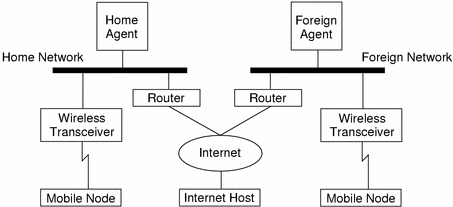Introduction
Current versions of the Internet Protocol (IP) assume that the point at which a computer attaches to the Internet or a network is fixed and its IP address identifies the network to which it is attached. Datagrams are sent to a computer based on the location information contained in the IP address.
If a mobile computer, or mobile node, moves to a new network while keeping its IP address unchanged, its address does not reflect the new point of attachment. Consequently, existing routing protocols cannot route datagrams to the mobile node correctly. In this situation, you must reconfigure the mobile node with a different IP address representative of its new location, which is a cumbersome process. Thus, under the current Internet Protocol, if the mobile node moves without changing its address, it loses routing; but if it does change its address, it loses connections.
Mobile IP solves this problem by allowing the mobile node to use two IP addresses: a fixed home address and a care-of address that changes at each new point of attachment. Mobile IP enables a computer to roam freely on the Internet or an organization's network while still maintaining the same home address. Consequently, computing activities are not disrupted when the user changes the computer's point of attachment to the Internet or an organization's network. Instead, the network is updated with the new location of the mobile node. See Glossary for definitions of terms associated with Mobile IP.
The following figure illustrates the general Mobile IP topology.
Figure 1–1 Mobile IP Topology

Using the previous illustration's Mobile IP topology, the following scenario shows how a datagram moves from one point to another within the Mobile IP framework.
-
The Internet host sends a datagram to the mobile node using the mobile node's home address (normal IP routing process).
-
If the mobile node is on its home network, the datagram is delivered through the normal IP process to the mobile node. Otherwise, the home agent picks up the datagram.
-
If the mobile node is on a foreign network, the home agent forwards the datagram to the foreign agent.
-
The foreign agent delivers the datagram to the mobile node.
-
Datagrams from the mobile node to the Internet host are sent using normal IP routing procedures. If the mobile node is on a foreign network, the packets are delivered to the foreign agent. The foreign agent forwards the datagram to the Internet host.
In the case of wireless communications, the illustrations depict the use of wireless transceivers to transmit the datagrams to the mobile node. Also, all datagrams between the Internet host and the mobile node use the mobile node's home address regardless of whether the mobile node is on a home or foreign network. The care-of address is used only for communication with mobility agents and is never seen by the Internet host.
- © 2010, Oracle Corporation and/or its affiliates
